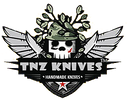Damascus Knife FAQ
1. What is a Damascus knife?
A Damascus knife is a blade made from multiple layers of steel, forged together to create a unique wavy or patterned design. It is known for its strength, durability, and sharpness.
2. Why is Damascus steel special?
Damascus steel is valued for its exceptional edge retention, toughness, and beautiful patterns. The layering process also enhances the blade’s durability.
3. Are Damascus knives good for kitchen use?
Yes! Damascus kitchen knives are highly sought after for their sharpness, cutting precision, and aesthetic appeal.
4. How do I maintain a Damascus knife?
- Keep it dry to prevent rust.
- Use a light coat of oil for protection.
- Store it properly to avoid chipping or damage.
- Sharpen it with a whetstone when needed.
5. Do Damascus knives rust?
Yes, if not properly maintained. Carbon steel Damascus knives are more prone to rust than stainless steel versions, so regular cleaning and oiling are essential.
6. Can I sharpen a Damascus knife at home?
Yes, using a whetstone is the best method. Avoid electric sharpeners as they can damage the layered steel.
7. Are all Damascus knives handmade?
Not necessarily. Some are hand-forged, while others are machine-made using pattern-welding techniques to achieve a similar appearance.
8. How can I tell if my Damascus knife is real?
- Real Damascus steel has patterns within the steel, not just on the surface.
- Acid etching enhances visibility, but the pattern should remain even after wear.
- Genuine Damascus knives usually come from reputable brands or blacksmiths.
9. Are Damascus knives expensive?
Yes, high-quality handmade Damascus knives can be pricey due to the craftsmanship involved, but there are also budget-friendly versions available For You
10. Where can I buy an authentic Damascus knife?
You can find them at specialty knife shops, online retailers, and custom knife makers. From TNZ Knives Who Make Quality Knives Since 2011
Viking Products FAQ
1. What are Viking Shields made of?
Viking shields were typically made of wood, often oak or linden, with a metal boss (the central round piece) to protect the user's hand. The shield’s edges were reinforced with metal bands to improve durability. Some Viking shields were decorated with intricate designs, including symbols and vibrant paint.
2. How were Viking Axes used in combat?
Viking axes were versatile tools for both fighting and daily life. They came in different shapes, including one-handed axes and larger two-handed battle axes. The axe's sharp blade was designed for chopping, cleaving, and striking in battle. It could also be used for throwing in some Viking warrior cultures.
3. What types of Viking Swords were there?
Viking swords were long, double-edged blades Semi Sharp, designed for both cutting and thrusting. They typically had a broad, flat blade with a pronounced fuller (a groove along the center of the blade to reduce weight) and a hilt with a round or pear-shaped pommel. Some famous types of Viking swords include the “Ulfberht” swords, known for their high-quality steel.
4. What is a Viking Hammer used for?
A Viking hammer, such as the iconic Mjölnir (Thor’s hammer), is often symbolic in Viking culture, representing Thor’s power over thunder and lightning. Historically, hammers were also practical weapons, used for smashing, striking, or as a tool for building and forging. The hammer’s design allowed for both precision and power in combat.
5. How do Viking shields and weapons compare to other medieval weapons?
Viking weapons, particularly their axes, swords, and shields, were designed for both function and durability. Vikings focused on versatility, with their axes often serving as tools as well as weapons. Compared to other medieval weapons, Viking gear was often more compact and practical for raiding, with axes being faster to use in close combat than long swords.
6. Are Viking weapons still made today?
Yes! Many modern craftsmen still create Viking-inspired weapons, using both traditional forging methods and modern materials. These are often used for reenactments, historical collections, or as practical items in certain combat sports like historical European martial arts (HEMA) On TNZ Knives
7. How do I care for a Viking weapon?
To ensure your Viking weapon stays in good condition, you should regularly clean and oil the blade to prevent rust. Shield faces should be kept dry and clean, and their wooden surfaces should be maintained to prevent warping. Always store your weapons in a dry, cool environment to avoid damage.
8. Where can I purchase Viking weapons or shields?
You can find Viking products at specialty shops, historical reenactment stores, or online marketplaces From TNZ Knives ensure you're purchasing high-quality, authentic replicas if that’s what you’re looking for.
9. Are Viking weapons and shields suitable for combat or are they just decorative?
Many Viking weapons and shields are designed as replicas for reenactments, but they can also be functional for certain forms of combat training. Authentic replicas made by skilled blacksmiths can be used in historical European martial arts or for training, but always make sure they meet the appropriate safety standards for use in such settings.
10. Can I customize my Viking shield or weapon?
Yes, many artisans offer customization options. You can choose specific designs, symbols, or engravings for your Viking shield, axe, sword, or hammer to give it a more personal touch. Some companies also allow you to select materials and finishes for a truly unique item You Can Contact On For Customization
Email: support@tnzknives.com


